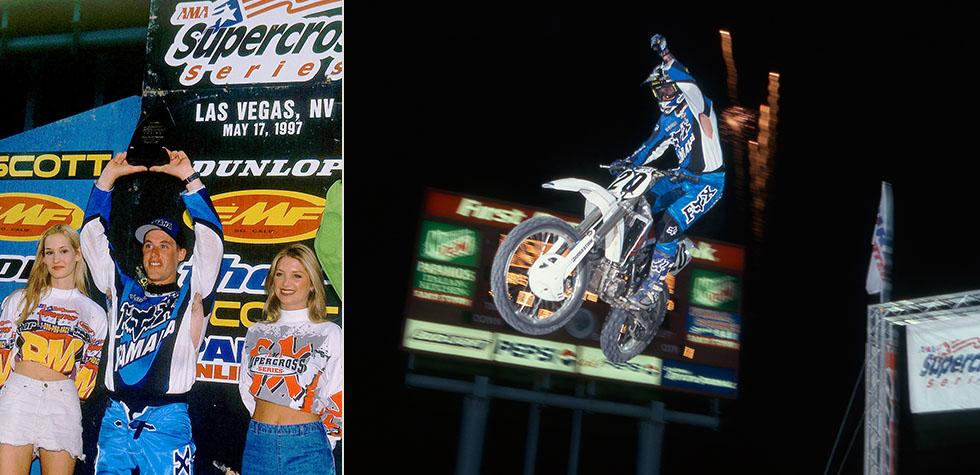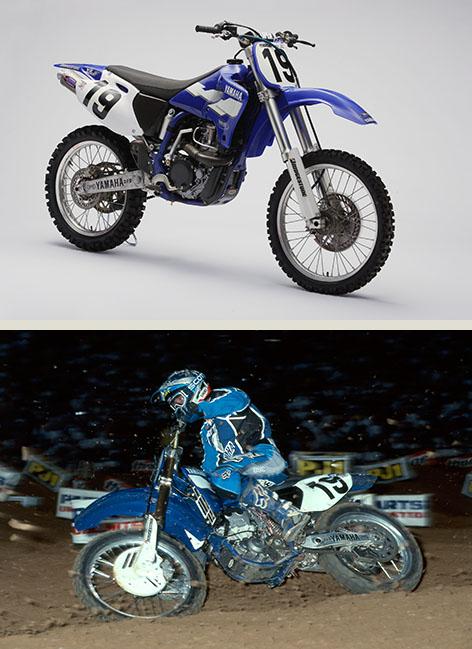In the spring of 1997, Yamaha developed a 4-stroke motocrosser that overturned the status quo of the two-stroke dominated motocross world.
At the time, motocross was dominated by the 2-stroke and the idea of racing a four-stroke was laughable. Despite this, Yamaha entered its revolutionary machine into competitions like the World Motocross Championships and the AMA Supercross Championship and won. The YZM400F factory machine ridden by A. Bartolini won a round of the WMX 500cc class at the Italian GP in April ‘97 and in May it won the Las Vegas round of the AMA Supercross in the hands of D. Henry. These two victories signaled the coming of a new era of 4-stroke motocrossers.
It started at Keith McCarty’s house, who was the Yamaha team manager at the time. During a conversation with Doug Henry, McCarty’s subtlety asked if he’d be interested in racing a four-stroke in the 1997 season.
“On a 4-stroke, I would do wheelies, go through the woods, ride with my buddies, they were just play-bikes [and not racing bikes],” Said Henry. “I remember like it was yesterday. I went to Keith McCarty’s house, I sat on his couch to discuss what we were gonna do for the next year and that’s when he told me that Yamaha wanted me to ride the 4-stroke and my heart kinda sank. “I was very skeptical [because I was used to riding 2-strokes and wanted to compete on the YZ250] and I couldn’t answer him right then and there; I had to think about it for a little while. … When it came down to it, I said, ‘Let’s do it and do the best we can.”
The bike Henry would ride was the YZM400F, a one-off factory machine. The YZM400F would compete in the 250cc class in which 4-stroke models of up to 550cc were allowed to compete. Meanwhile, the Motocross World Championship had 125cc, 250cc and 500cc classes that were run as separate series and there were no 4-stroke displacement allowances, so Yamaha planned to have the YZM400F compete in the 500cc class.

The development team in charged of building the YZM400F, led by Masakazu Shiohara had never designed 4-stroke engines or worked on a motocross bike before. In the end, starting completely from scratch and with their lack of preconceptions was largely why they ended up creating a revolutionary 4-stroke motocrosser. From the very start it was already decided that the chassis would take on the dimensions of the YZ250. The team mounted a TT250R engine in a YZ250 frame and tried it out but it was too heavy for competitive use.
The breakthrough came with engineer Kenji Tamura took the cylinder head and camshaft of a YZF750 engine and sawed off the sections for a single cylinder. He then paired it to the cylinder of a TT250R engine (YZF bore: 72 mm; TT250R bore: 73 mm) using welding and putty to make a prototype 250cc engine. The engine revved up to 13,000 rpm and had power roughly between that of a 125cc and 250cc 2-stroke engine. Mounted in a YZ250 frame, it ran unexpectedly well and the bike weighed just under 110 kg.
Eventually, the YZM was given a displacement of 400cc with a bore × stroke of 95 mm × 56 mm but why didn’t they take the displacement all the way up to the 500cc limit allowed?
A 500cc four-stroke motocross bike would have been too heavy to justify the extra power. And the other reason was in the equation 250 × 1.6 = 400. 2-stroke engines produce1.6 times the power of a 4-stroke per unit of displacement. This led to the calculation that making a 4-stroke engine with power equivalent to a 250cc 2-stroke would require 1.6 times the displacement, which comes to 400cc.

Developing the YZ Production Model
As development for the YZM400F factory machine steadily progressed, the develop of the YZ400F production model was already underway. With the success of the YZM400F, Project leader Yoshiharu Nakayama decided that 4-stroke models would be added to the existing 2-stroke lineup.
To minimize the height of the cylinder head as much as possible, the DOHC engine adopted a 5-valve format and the bore × stroke of the YZ400F was made 92 mm × 60.1 mm as opposed to the YZM400F’s 95 mm × 56 mm spec. Also, the frame for YZ400F was a model-specific design rather than replicating the one on the factory machine.
“In order to meet the deadlines for the production model’s manufacturing schedule, we didn’t have time to wait for feedback from the factory bike,” says Nakayama. “Because production models come with numerous conditions like costs, reliability and manufacturing efficiency, we couldn’t do things in the same way. On top of that, we also had to conduct simultaneous development of the WR400F as the sister model to the YZ400F. For a project like this to be successful, we have to be able to expect a certain volume of production in order to get a return on capital investment, etc. So, initially we pushed through a production plan of 3,000 units for the YZ400F and 6,000 for the WR400F.”
The testing for the YZ400F took place in the United States with representatives from Europe present as well. “No one believed us when we told them we were developing a 4-stroke production motocrosser, and the more knowledgeable about motocross they were, the more skeptical they became,” Said Nakayama.
“Even in the U.S., they thought it would be like a 400cc version of the TT500, so we took a YZ400F prototype to America to get them to actually ride it themselves before passing judgement. We ran tests at places like Carlsbad, Glen Helen Raceway and Los Angeles County Raceway, and the response was quite good; people were really surprised. We had also invited Stéphane Peterhansel over from Europe. I remember his eyes were wide with astonishment the moment he took off his helmet after his test ride and shouted, ‘That was a surprise!’”

The Big Day
It was only one week before the last round of the 1997 Supercross championship in Las Vegas that the news broke about the YZM400F entering the event. In Europe, Andrea Bartolini had already ridden the YZM400F to its first GP victory in Italy. There was no doubt that things were turning in their favor and Las Vegas is a place where everyone comes with high hopes of winning. There was certainly no better place to gamble on success for the YZM.
The gate dropped at Las Vegas and Henry took the holeshot to grab the lead and immediately opened up a 2-second gap. Henry’s rhythm wasn’t thrown off in the whoops and he was able to hold a straight line through them, a perfect display of the four-strokes undeniable stability. Henry’s ride was making the weak points of the 2-strokes very obvious. At full throttle while running over a bump, the 2-stroke’s sudden burst of power tended to throw the rear wheel sideways, or when opening the throttle to accelerate, the power would cause the rear wheel to spin instead of grip. In contrast, Henry’s 4-stroke had none of these tendencies.
When Henry took the checkered flag after 20 laps, he and the YZM400F took the first win on a 4-stroke in AMA Supercross history and had won the awe and admiration of all the fans watching. Leading every lap of the race, this perfect win had proven the machine’s awesome potential.
Henry recalls: “I remember getting to Vegas with the 4-stroke for its debut, and Mike Kiedrowski walking by laughing and saying, ‘Do you really think you’re gonna qualify on that thing?’ But I knew that we could win during the tests in Carlsbad that Thursday. Once we got the carburetion set up right, I knew we had a really good bike.”

Arrival of the production model
Just three months after the factory machine made its racing debut, the YZ400F 4-stroke production motocrosser was unveiled in June 1997. Although they would have to wait until that year’s autumn motor shows to see the WR400F enduro bike.
Henry continued to ride a four-stroke in 1998, however he switched to the YZ400F production model and scored four 3rd-place finishes in Supercross and five overall wins in the AMA 250cc Motocross Championship to take the title.
“The prototype YZM400F was light and powerful and the production YZ400F had even better handling. [So it’s hard to say which was better.] But, it was a combination of seat time on the 4-stroke bike and being stronger and training more that helped win the title,” says Henry.
With its development of the YZM400F factory machine and YZ400F production motocrosser, Yamaha overturned the long-held belief of the industry (and the sport of Supercross) about 4-stroke motocrosser capability and competitiveness. This pioneering of 4-stroke machinery in the category and the subsequent advances made possible by starting development with premier-class off-road models would lead to substantial growth in the number of off-road enthusiasts worldwide.

Doug Henry’s YZM400F
